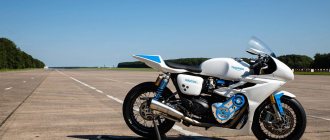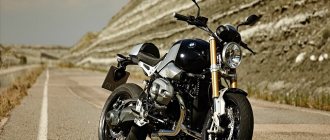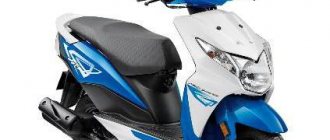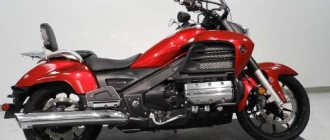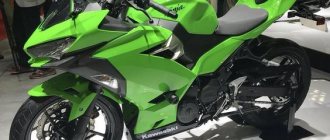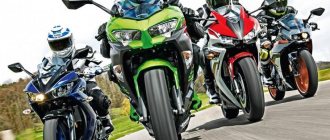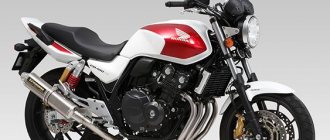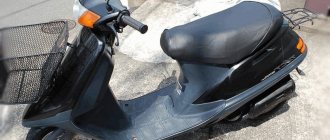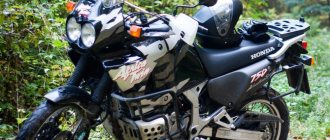History of HONDA motorcycles
Honda was founded in the late 40s of the 20th century, when post-war Japan made every effort to recover from the ruins of World War 2.
At this time, the company's founder, Soichiro Honda, launched a small business producing piston rings, but a year later began producing the first inexpensive mopeds. Since childhood, Soichiro Honda was possessed by the desire to devote himself to the design of cars and motorcycles, and his genius was revealed in all its beauty in the 1960s - during the heyday of the company, when Honda motorcycles began to win the first awards on the race tracks. At the moment, Honda is a recognized leader in the world of motorcycles, producing the most advanced models of two-wheeled vehicles. Today we present to you a brief chronology of the development of this brand.
1906 - Soichiro Honda was born in the Hamamatsu province of Japan into the family of a poor blacksmith. His father gradually masters the craft of a bicycle repairman, thanks to which Soichiro becomes familiar with technology for the first time. As a teenager, he gets a job as a mechanic's apprentice at an auto repair shop in Tokyo.
The first photograph of Soichiro Honda, taken during the period of time when he worked in a car repair shop.
1928 - Soichiro Honda returns to Hamamatsu and opens his own auto repair shop. A fanatical racing fan, he builds his own racing car.
1936 - During the next sports racing competition, Soichiro Honda has an accident and is seriously injured.
1937 - Soichiro Honda opens a company producing piston rings. At first, his company experiences difficulties, since Soichiro simply has no experience in this field. However, over time, the company becomes the main supplier of piston rings for Toyota, which during these years began producing its first cars.
Piston ring workshop
1946 - Soichiro Honda sells its piston ring manufacturing business. The country is in the throes of a deep post-war crisis. Soichiro realizes that as industry, the economy and normal peaceful life are restored, affordable transport will become very popular and starts a new business - installing small and inexpensive two-stroke motors on bicycles, which were used as generators for military radio stations during the war.
One of the bicycles converted at Soichiro Honda's workshop. Today many people call them Honda Model A.
1948 – Honda Motor Co. is founded. Ltd. Soichiro Honda focuses on technological processes, transferring control of all financial matters to his associate Takeo Fujisawa.
1949 - the company produces its first motorcycle with a 98cc two-stroke engine. One of the assembly shop workers, seeing the new product, calls it like a dream. This name, “Dream,” stuck with the motorcycle, although it is officially known as “Model D.”
Honda Model D
1951 - for several post-war years, the streets of Japanese cities are crowded with loud and very unenvironmentally friendly motorcycles with two-stroke engines. Honda begins development of its first motorcycle with a four-stroke “Dream E” engine (displacement 146 cm3)
Honda Dream E
1952 - despite the fact that Soichiro Honda, by his own admission, does not like “primitive mopeds,” his company develops and begins very successful sales of Cub F mounted motors with a displacement of 50 cm3, which are installed on bicycles. The motor is sold in stores throughout Japan. Honda will continue to produce this engine for the next two years, and then “Cub” will become an independent brand that will be popular for several decades.
Honda Cub outboard motors, which are installed on bicycles, are still popular today, for example in India.
1953 - the Benly J model appears with a 4-stroke 90 cm3 engine. It quickly gained popularity among amateur motorcycle racers and existed for two decades, leaving a memory as one of the most reliable Japanese motorcycles of the 50s.
Honda Benly J
1954 - This year, Soichiro Honda shared with his colleagues and descendants his dream of achieving success in Grand Prix motorcycle racing. He wrote: “My childhood dream was to become a motorcycle racing champion. I had to take first place on a motorcycle of my own design. However, as I got a little older, I realized that before you can win championships, you need to build a strong corporate structure, establish production, and create superior design. In recent years, we have been doing this and today we offer the Japanese products of very high quality, but we have not even begun to make efforts to participate in motorcycle racing. I promise to take part in the Isle of Man TT race and will put all my energy into winning it.”
A few months later, Soichiro Honda goes to the TT motorcycle race and attends it as a spectator. There he pays close attention to the German NSU motorcycles, which were considered the favorites in the 125 and 200 cc classes. This fact may have led to subsequent rumors that Honda copied these motorcycles, although there are a number of significant design differences between the NSU and Honda models.
Isle of Man TT race in the 1950s
1957 - a number of leading Italian motorcycle manufacturers, including MV Agusta, Gilera and Mondial, announce the withdrawal of their teams from the world motorcycle championship under the pretext of high costs. MV Agusta subsequently reverses this decision and returns to racing, and racing motorcycles from other manufacturers are sold. One of them (the Mondial racing model) is purchased by representatives of Honda. Japanese motorcycle designers did not copy this Italian motorcycle. He served as their inspiration and the standard to which they aspired.
1958 - the market is shocked by the appearance of the Super Cub model (it also has such designations as C100, CA100, Honda 50). Its distinctive features are a stamped steel frame, a lever fork and a 50cc four-stroke engine. Subsequently, models with 70 and 90 cc engines appeared. This motorcycle has become the most popular two-wheeled motorized vehicle in the world.
Honda Super Cub
1959 - Honda takes part in the famous Isle of Man TT championship for the first time. 5 motorcycles in the “Ultralight” class with two-cylinder engines are put up for the start. Rider Naomi Tanaguchi achieved the team's best result, finishing sixth overall. Honda wins the manufacturer's cup.
1961 - Honda motorcycles gain complete dominance in the 125 and 250 cc classes of the Isle of Man TT Championship. Honda's Mike Hailwood took first place in both classes. The Isle of Man Examiner newspaper published on this day with the headline “East wins unconditional victory” on the front page.
Soichiro Honda at the Isle of Man TT motorcycle race.
1963 - Honda concentrates on Formula 1 car racing. For this reason, the motorsports industry is experiencing some difficulties. However, motorcycle sales remain very impressive. The Super Cub model has won awards due to its popularity.
This year, Honda opens its first foreign assembly plant - a plant in Belgium.
1964 - models with two-stroke engines begin to dominate in the class of small-capacity motorcycles. To successfully compete in the 250cc class, continuing to rely on 4-stroke power units, Honda releases the 3RC164 model with a 250cc six-cylinder engine. This technical work of art makes a huge impression on the world of motorsports, but it is Phil Read on a Yamaha who wins this year's championship. However, in 66 and 67, Mike Hailwood came to the finish line first at the 250cc world championships on the 3RC164 model.
Honda 3RC164
1968 – 19 years after Honda rolled out its first two-wheeled vehicle with a motor, the company produces its 10 millionth motorcycle.
1969 - At the Tokyo Motor Show, Honda introduces the CB750, a motorcycle that forever changed the idea of what a modern city bike should be.
Honda CB750
1970 - Honda enters four drivers in the Daytona 200. Only one of them finished, Dick Mann, but he finished first, overshadowing the failure of the other team members. Riding a Honda CB750 Racing Type, specially prepared by the company's racing division, Dick Man left Triumph and Harley-Davidson XR750 motorcycles behind.
1972 - Honda designers recognize that in order to build a motocross motorcycle capable of competing on equal terms with competitors, it is necessary to develop a new two-stroke engine. The new engine was installed on the CR250 Elsinore, which immediately received recognition from athletes as one of the best motocross motorcycles.
Honda CR250 Elsinore
1973 - Soichiro Honda resigns as president of the company, but remains a member of the board of directors; employees call him “Chief Advisor” among themselves.
1974 - the beginning of production of the legendary Honda Gold Wing model - GL1000. It was first presented to the public at a motorcycle exhibition in Cologne, and just a year later it began to be actively sold on the US market. The motorcycle has the first four-stroke liquid-cooled engine. In addition, it uses a cardan shaft as the main gear. Another innovation was the fuel pump - its installation was required because the Gold Wing had two fuel tanks - one between the handlebars and the seat and the second hidden under the seat for optimal mass balancing of the motorcycle.
Honda GL1000
1978 - Honda is trying to create a powerful sports motorcycle specifically for participation in the 500GP series of the world motorsports championship. It was the NR500 model, whose V-shaped four-cylinder engine used oval-shaped pistons. This was a real breakthrough for engine designers. However, during testing of the motorcycle, many problems were identified that were resolved only a year later. However, in the races, the Honda NR500 suffered one failure after another and ultimately did not bring the company’s motorcycle team a single victory.
Honda NR500
1981 - Production of the Gold Wing model moves from Japan to a new assembly plant in Ohio in the USA.
1983 – Honda team driver Freddie Spencer wins the world championship in the 500cc class for the first time. Previously, the company had managed to win in this class only in the Manufacturers' Cup in 1966.
1986 - After an unsuccessful experience with V-shaped four-cylinder engines in the late 70s, Honda nevertheless returns to this engine layout and releases the VFR750F Interceptor model. For the next ten years, this motorcycle was considered the best road bike.
Honda VFR750F
1987 - the company releases the CBR600F model - the first four-cylinder streetfighter with a full plastic body kit.
Honda CBR600F
1990 - four years after the start of production, the Honda VFR750R (special sports version) is sold in the United States for the first time. It's priced at double the price of a regular stock Interceptor model.
Honda VFR750R
1991 - The company mourns the death of its founder Soichiro Honda, who died of kidney disease.
1992 - a limited edition of the legendary NR motorcycle was released, which competed in MotoGP races without much success. Its civilian version is equipped with a 750 cm3 engine. and unique for its time carbon fiber body, digital instrument panel, cantilever swing arm and electronic fuel injection. Despite the widespread use of ultra-light materials, the weight of the model exceeds 200 kilograms, and the price is breathtaking - 60,000 US dollars!
Honda NR750R
1993 - The sports world is turned upside down after the presentation of the first sports bike, the CBR900RR. The creation of designer Tadao Baba combines the power of an open class motorcycle with the weight and handling of a 600.
1995 - a new specially prepared cross-country motorcycle Honda EXP-2 with a two-stroke 400 cc engine takes first place in its class in the Grenada-Dakar rally. Its engine, thanks to the use of a floating exhaust valve, uses complete fuel combustion technology.
2001 - Valentino Rossi wins the world championship in the 500 class, riding a motorcycle with a Honda NSR500 two-stroke engine. The following year, the championship organizers abandoned races in this class.
Honda NSR500
2002 – Valentino Rossi wins the MotoGP 990cc championship. see model RC211V, equipped with a five-cylinder, four-stroke engine.
Honda RC211V
2004 - Honda releases a prototype motorcycle whose engine receives energy from fuel cells.
2006 – 50 millionth Super Cub model sold
2007 - Honda becomes the first motorcycle manufacturer to equip one of its models (Honda Gold Wing) with an airbag.
Honda Gold Wing – airbag demonstration
2010 – VFR 1200F model introduced. Although this is not a sportbike, as fans of the brand expected, no one was disappointed in the motorcycle. Its main advantage was the optional transmission with two clutches, the speed of which can be changed using buttons.
Another bright premiere of this year was the Honda Fury model – a classic road motorcycle in the “chopper” style. The new product gave experts reason to say that Honda again wants to enter into fierce competition with Harley-Davidson, as it was in the 60-70s of the last century.
Honda VFR 1200F
Honda Fury
2011 - Honda makes an attempt to return to the segment of small-capacity sportbikes and succeeds with the release of the Honda CBR 250R model, equipped with a 249 cm3 engine. The motorcycle is produced at the company's assembly plant in Thailand and sold throughout the world.
Honda CBR 250R
Well, at the end of the material I would like to say a few words about the legendary line of sports motorcycles CBR600RR and CBR1000RR with 599 and 999 cc engines, respectively. Since the start of their production in 2003, they have been sold all over the world in huge quantities, initially absorbing technologies from MotoGP. Every year the manufacturer makes changes to the design, increasingly improving the engine, transmission and handling of the bikes.
2013 Honda CBR600RR
2013 Honda CBR1000RR
Undoubtedly, the history of Honda will not end soon; we are confident that the management of the concern will delight and surprise us more than once with its bold, high-tech and fast-paced ideas and results!
Honda motorcycles
Numerous Honda motorcycles travel all over the world. In Russia they invariably enjoy enormous popularity , and many motorcyclists would never trade a bike of their favorite brand for anything else. Having worked for decades to create a positive reputation, the Japanese company has achieved its goal, and the motorcycles of this brand have long become the standard of reliability. Moreover, initially Honda did not even produce motorcycles, specializing exclusively in cars, but those days are long gone, and the concert has significantly expanded its profile. The modern model range includes equipment of all existing classes, and here are just some of its notable representatives.
- CB 125 . The main competitor of the favorite of all novice motorcyclists is the Yamaha YBR-125.
- CB 400 SF (Super Four) . Probably the most common imported motorcycle in Russia, despite the fact that it was officially produced only for the Japanese domestic market.
- VTX 1300 and 1800 . Chrome plated, shiny and heavy. Like many other choppers, they were equipped with a cardan drive.
- CBR600RR and CBR1000RR . Continuers of the famous Fireblade series, real plastic rockets, albeit with new names.
- GL1500 and GL1800 Gold Wing . Perhaps the most popular luxury tourers in the world, competing equally with the Harley-Davidson Electra Glide.
Why do people love Honda motorcycles?
Of course, for the legendary reliability! Well, prices make a positive contribution to popularity, since the Honda motorcycle catalog also includes inexpensive models. Moreover, the available line expands almost every year, and is replenished with more and more new models of motorcycles of all classes. The company is also experimenting in other directions, producing millions of scooters for the Asian market and beyond - in Europe, for example, the Integra 700/750 maxi-scooter has already proven itself well.
The popularity of Honda road motorcycles also remains consistently high, all models of which are distinguished by reasonable prices, balanced technical characteristics and attractive design, which is easy to verify by simply looking at photos on the Internet. Do you want a sport motorcycle? Then take a closer look at the CBR line, which has models with engines from 125cc to 1000cc. Do you like traveling with maximum comfort? Gold Wing is created especially for you. Do you like to drive long distances with the breeze? Choose any bike from the VFR family. All Honda motorcycles are good in their own way, and which one to choose is a matter of personal taste and budget. The choice is somewhat made easier by the fact that the available models and their modifications differ greatly in cost, and choosing something for yourself is not difficult.
At the same time, it cannot be said that Honda motorcycles are definitely better than the products of other representatives of the “big Japanese four” - Yamaha, Kawasaki and Suzuki. Each of these manufacturers has its own characteristics, strengths and weaknesses, and they are all good in their own way, which is why they also have entire armies of fans.
